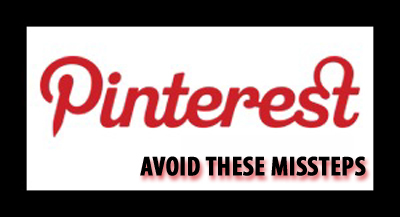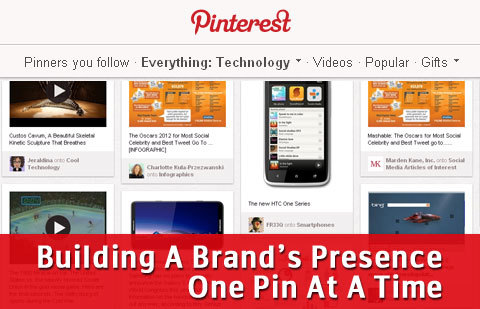
25 Mistakes To Avoid on Pinterest
( Pinterest Don'ts for businesses and marketers )
1. Not including your business information.
The first step in getting started on the right foot on Pinterest is to create a profile that is full of details and represents your business. Upload a clear, easy to recognize logo for your profile picture and use your business name as your profile name. Put your company's website and what you are all about in the description.
2. Forgetting to link to Facebook and Twitter.
If a customer is interested in your brand on Pinterest, they’ll likely want to follow you on Facebook and Twitter too. Make sure they can do so by linking to these social networks within Pinterest’s “Account Settings.” Make it easy for them to follow you on other networks
3. Failing to complete your profile.
When you have a business account, you can select your “business type,” add your location, verify your website, and create a short “About You” section for your profile. Completing your entire profile is important for SEO purposes and helps you look more professional.
4. Using a personal Pinterest profile instead of a business page.
If you jumped on Pinterest in the beginning, you may still have a personal account. But as a business, you want to make sure that you setup a Pinterest Business Page. Without a business page, you’re missing out on valuable analytics! Make the switch to a business page today.
5. Not following other businesses.
The nature of Pinterest is based on collaboration. Find other local businesses in your area to engage with and stay updated on what your customers are pinning alongside items from your business. Also, look to other businesses similar to yours on Pinterest for inspiration.
6. Mixing your personal interest boards with business-related boards.
There are actually a few instances this can be done successfully, but overall this tactic doesn’t work. Are your customers actually interested in the recipes you’re considering trying or the table settings you want at your fantasy wedding? Maybe but probably not. Keep your business account for your business and your personal account for your personal interests.

7. Pinning images that aren’t Pinterest-worthy.
Avoid pinning content that is too big, too small, too blurry or simply low quality. NOTE: Max image size: 554 pixels wide X 5000 pixels high.
8. Not installing the “Pin It” button on your browser.
It’s simply something you’ve got to do because the “pin it” button makes it super easy to curate content from any website. With a quick click, you can pin an image that contains a description and a website link. Simply highlight the text you want as the description before you click “Pin it.”
9. Keeping your “Search Privacy” turned on.
Allowing your boards and profile to appear in search engine results is a great way for new customers to discover your business. Make sure that you’ve turned your “Search Privacy” off within your “Account Settings.” How else is anyone gonna find you if you have Privacy turned on, doh ?!
10. Using inappropriate pins or repins.
Don’t forget that your Pinterest Page is an extension of your brand. Stick to images that you’d feel comfortable sharing with anyone. Anything that doesn't match is gonna stick out and may not identify with your brand, company, or image you are trying to portray.
11. Going on day-long pinning sprees.
Posting too many pins at one time can overwhelm your fans. Try not to pin more than five images within five minutes. If you want to dedicate a specific time in the day for expanding your Pinterest channel, try to put at least five to ten minutes between batches of pins.
12. Neglecting to choose a category for each of your boards.
For each new board you create, you should choose a “Category” from the drop-down list. Selecting an appropriate category for your boards will make your content searchable.
13. Not adding a pin description or link source to pins.
You can write up to 500 characters within a pin description so don’t skimp on the information you add! Use keywords related to your business, words or phrases people would search for, and relative hashtags to maximize your description’s context. When appropriate, link back to your website, other social networks, and your blog to drive traffic to your business. Insider tip: Pinterest is a powerful SEO tool!
14. Not taking advantage of Pinterest’s retail features.
By simply adding the price of the item featured with a dollar sign, you can add a “price tag” to your pin. Pins that include a price tag get 36 percent more likes than those that don’t! If your item goes on sale, Pinterest even alerts the people who have repinned your product!
15. Abusing #hashtags.
Only use necessary hashtags and delete the rest to avoid looking spammy.
16. All of your content is the same.
Include various types of content throughout your boards such as repins, content from your own website, content curated from other websites or uploaded content. Don’t forget, you can also pin videos!
17. Not finding a balance.
Pinning too many images from your website or blog or only pinning images from your website or blog is not ideal. Vary the content you post to keep it fresh and engaging. See mistake #16.
18. Not telling anyone your business is on Pinterest.
Use the networks you already have (Facebook, Twitter, word-of-mouth, email subscribers etc.) to spread the word. Adding a Pinterest logo to your website or blog will also help grow your following and act as a reminder to people who visit your website to pin your content.
19. Dumping all of your content into one board.
Use numerous boards to keep your content organized and easy to navigate. Smaller, more specific boards allow your fans to quickly pinpoint content that interests them, spurring engagement.
20. Ignoring Pinterest Analytics.
As a small business owner or nonprofit, your time is limited. Don’t waste it! If you’re not reviewing the analytics that Pinterest provides, how will you know if your efforts are having an effect on your business? Knowledge is power, use the tools you are provided with get to that knowledge.
21. You pin anything.
It’s easy to get lost in a sea of stunning images where you might find yourself repining anything that catches your eye. Don’t do it. As a brand, you’re trying to relay a message that portrays what your business is all about. Plan out your boards and outline what message or information you want your fans to walk away with before you start pinning.
22. Forgetting traditional social media best practices.
Commenting isn’t the most popular form of engagement on Pinterest, but it is still important to monitor what your fans are saying and doing. Look for opportunities to respond and engage with potential customers too. Also, similar to other social networks, always remember to stick to a consistent content frequency that works for you.
23. Neglecting Pinterest’s unique features.
You can enable Pinterest’s collaborative function “me+contributor” on the boards you select. This function allows others to contribute to your boards as “guest pinners.” You can also create secret boards to develop content before publically showing it off.
24. Overlooking your website’s content.
Is it pinnable? Make sure your customers can pin from your website or blog. Test it out before you encourage customers to pin your images and if you don’t have great visuals on your site, get some!
25. Thinking that B2Bs don’t belong on Pinterest.
As a B2B on Pinterest, there’s actually a lot you can do to humanize your brand and tell your story through visuals. Pinterest allows you to showcase the people that make your business a success, industry statistics or news, your brand’s content or useful information, and tips your customers can benefit from.
You don’t need to be a retail brand to be successful on Pinterest either. Did you think pinning was as simple as picking up a corkboard and tacks from your local craft store? Don’t worry, by being aware of mistakes to avoid on Pinterest, you’ll find success! If you’re still feeling overwhelmed about getting started on Pinterest, remember these tips of what NOT to do and do the do the opposite. At most complete your profile and link all of your social networks and start creating one category at a time and pin daily until you have a good collection that is Pinterest worthy !!
Easy access to the data. For years, businesses have gathered transnational data from numerous software systems and compiled it in an effort to improve their business processes.
ReplyDeleteTo be successful, you can't rely on your old way of doing things. Buyers don’t need salespeople to educate them on products and services anymore. They want ideas on what they can do to improve their businesses -- not just a solution for today’s issues.
ReplyDelete